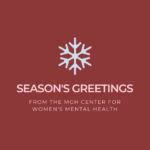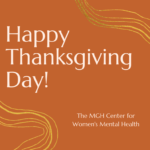2015 was a great year for the Center for Women’s Mental Health. We have been growing by leaps and bounds, and over the last year our readership has nearly doubled.
We are grateful to our readers who continue to help us bring the material from our website to the women who need reliable and up-to-date information in order to make thoughtful and informed decisions regarding their care.
And 2015 was another tremendously productive year in the world of reproductive psychiatry:
Autism and Antidepressants
Articles asserting a link between prenatal exposure to antidepressants and risk for autism spectrum disorders (ASD) continue to generate media buzz.
Estimating the Impact of Untreated Maternal Illness
When we advise women regarding the safety of psychiatric medications taken during pregnancy, we must weigh the risks of medication exposure against the risks of untreated depression in the mother.
Taking medication carries some risk; however, untreated illness can also pose risk to the developing fetus.
Earlier this year, we reviewed a study suggesting that prenatal exposure to depression in the mother may permanently alter the structure and organization of the fetal brain.
On the flip side of that study is the report suggesting that treatment of mother’s depression with antidepressants may actually lead to better pregnancy outcomes.
More Safety Data on Some Newer Medications
When selecting medications for use during pregnancy, we tend to gravitate toward the older ones because there is usually more data to support their reproductive safety. Our data regarding the safety of newer psychotropic medications is growing but still limited.
In 2015, new information was published on venlafaxine and duloxetine, indicating no increase in risk for congenital malformations.
While a meta-analysis provided reassuring data regarding the reproductive safety of gabapentin, other studies suggested that exposure to topiramate (Topamax) during pregnancy may be associated with an increased risk of cleft lip and palate.
Several studies reported on the outcomes of children exposed to newer antipsychotic medications; however, our data remains limited. The National Pregnancy Registry for Atypical Antipsychotics will continue to evaluate the safety of atypical antipsychotic medications taken by women during pregnancy.
Moving Ahead with Universal Screening for Perinatal Depression
A big step was taken earlier this year, when the American College of Obstetricians and Gynecologists (ACOG) Committee on Obstetric Practice published an opinion on screening for perinatal depression, recommending that “clinicians screen patients at least once during the perinatal period for depression and anxiety symptoms using a standard, validated tool.”
But as we move toward universal screening, we must make sure that screening is seamlessly connected to follow-up and treatment. What has been made clear from recent studies is that screening for perinatal depression substantially improves detection; however, screening alone does not improve rates of treatment or outcomes. We clearly need to do more.
In the Press: A Better Understanding of Women’s Mental Health Issues?
2015 was not without its anxiety-provoking and often misleading headlines, but is does seem that there is a growing number of thoughtful and well-informed articles dealing with perinatal mood and anxiety disorders.
There was the eloquent piece by Andrew Solomon in the New York Times. And it seems that more and more articles about depression during pregnancy and the postpartum are appearing in a wide variety of media outlets, such as Buzzfeed and Huffington Post.
We can only hope that this trend continues.
Well, that’s it for 2015. Wishing all of our readers and their families a Happy and Healthy New Year!
Follow us on Twitter @wmnmentalhealth
Ruta Nonacs, MD PhD








Happy New Year! What a year 2015 was for you guys. You are reaching more women and empowering us to be aware and strong. I must say Buzzfeed is actually posting videos related to women’s health and depression. Hoping more websites are following the trend.